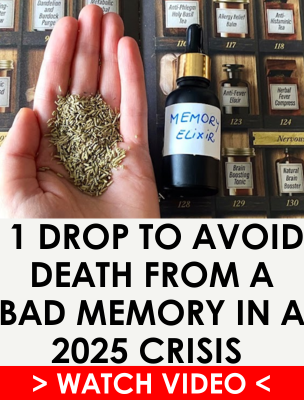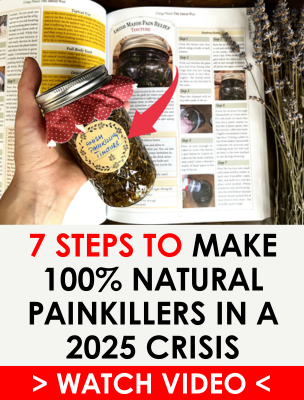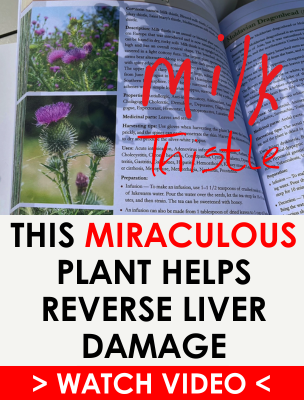You won’t find an Amish family rushing to the ER for every cough or scrape. Why? Because for centuries, they’ve had their own medicine cabinet—one that grows wild in fields, backyards, and forests. While modern preppers stockpile antibiotics and painkillers, the Amish have been quietly relying on the same handful of plants their ancestors used. And in a long-term survival scenario? That knowledge could save your life.
Here’s the thing: The Amish don’t just use herbs because they’re “old-fashioned.” They do it because it works. No pharmacies, no insurance, no backup plan—just raw, tested plant wisdom passed down through generations.
So, how about we look at the most trusted medicinal plants in Amish tradition, how to use them, and why you should start growing them now?
Why the Amish Turned to Herbs in the First Place
The Amish didn’t turn away from modern medicine out of stubbornness or ignorance—their preference for herbal remedies stems from deep cultural values and hard-learned lessons. For generations, they’ve maintained this self-reliant approach not as a rejection of progress, but as a conscious preservation of what works.
These are the three fundamental beliefs shape their medicinal practices:
First, self-sufficiency lies at the heart of Amish life. Why rely on hospitals, pharmacies, and supply chains that could collapse in a crisis when the land itself provides healing? Their communities thrive on independence, and herbal medicine fits perfectly—no prescriptions, no shortages, just the knowledge of which plants treat fever, infection, or pain.
Second, their faith reinforces this practice. The Bible mentions healing herbs multiple times, such as the “bitter herbs” of Exodus or Ezekiel’s vision of trees whose “leaves were for healing.” Many Amish view these passages as divine endorsement of plant-based remedies, making their use both practical and spiritual.
Third, history taught them caution. When early Amish immigrants encountered 19th-century “English” doctors, they saw dangerous practices like mercury poisoning and bloodletting—treatments that often killed rather than cured. Herbal medicine, passed down through families, proved far safer.
This wisdom wasn’t learned from textbooks but through oral tradition—mothers teaching daughters, elders instructing the young. Every remedy was tested not in labs, but in real homes, with real illnesses. The proof wasn’t in peer-reviewed studies, but in children who recovered from fevers, wounds that healed cleanly, and generations that stayed healthy without hospitals.
Even today, while some Amish will seek modern care for serious conditions, most households still keep their trusted herbs close at hand. It’s not just tradition—it’s a living system of medicine that has stood the test of time. And in an uncertain world, that’s knowledge worth preserving.
The Amish Medicinal Plants
For generations, the Amish have turned to the plants growing around them rather than rushing to doctors at the first sign of illness. This isn’t just tradition – it’s practical wisdom born from necessity and proven through experience.
Yarrow: The Wound Warrior
Walk through any Amish farm and you’ll find yarrow growing near the barn or kitchen door. This unassuming plant with feathery leaves and clusters of tiny white flowers serves as their go-to emergency medicine. The Amish call it the “nosebleed plant” for good reason – its remarkable ability to stop bleeding has made it indispensable.
My grandfather, who lived with the Amish in Ohio for 3 years, once watched an Amish farmer treat a deep axe cut on his son’s leg. Without hesitation, he grabbed a handful of yarrow leaves, chewed them briefly, and packed the green mash directly into the wound. Within minutes, the bleeding slowed to a trickle. This same technique has been used in their community for generations, proving its worth time and again.
Beyond wound care, yarrow serves multiple purposes in Amish homes. A tea made from flowers reduces fevers, acting much like aspirin without the side effects. During the cold season, you’ll find jars of yarrow tincture in many Amish pantries, ready at the first sign of illness. The plant’s antibacterial properties make it useful for cleaning minor wounds when proper antiseptics aren’t available.
Plantain: The Humble Healer
What most people consider a bothersome weed, the Amish recognize as nature’s band-aid. Broadleaf plantain grows abundantly around Amish homesteads, and they make excellent use of it. The leaves contain compounds that reduce inflammation and promote healing, making them ideal for all sorts of skin irritations.
During harvest season, it’s common to see Amish workers chewing plantain leaves and applying them to bee stings or bug bites. The simple act releases the plant’s healing juices and provides immediate relief. For more serious skin issues, they prepare a salve by simmering the leaves in lard or olive oil, creating a soothing ointment that lasts through winter.
One Amish grandmother shared with my grandfather her family’s remedy for poison ivy – a poultice of crushed plantain leaves applied several times daily. She swore it worked better than anything from the pharmacy, having used it successfully on her children and grandchildren for decades.
Mullein: The Respiratory Rescuer
Towering mullein plants with their soft, fuzzy leaves are a familiar sight in Amish gardens. This biennial herb earns its place through remarkable respiratory benefits. When coughs and congestion spread through their communities, as they often do in close-knit families, mullein provides reliable relief.
The Amish prepare mullein in several ways. For chest congestion, they brew tea from the dried leaves, often sweetening it with honey from their own hives. More severe cases might call for mullein leaf smoke – not inhaled deeply, but used like a medicinal vapor to open airways. Some families still keep a “mullein pipe” for this specific purpose.
Perhaps most impressive is their use of mullein oil for ear infections. By steeping the flowers in olive oil for several weeks, they create a natural remedy that rivals commercial eardrops. Amish mothers use this on teething babies with remarkable results, a tradition passed down through countless generations.
Comfrey: The Bone Knitter
No discussion of Amish herbal medicine would be complete without comfrey, known to them as “knitbone.” This vigorous plant with large hairy leaves and bell-shaped flowers contains allantoin, a compound that stimulates cell growth and speeds healing.
The Amish primarily use comfrey externally, despite historical internal use. For sprains, fractures or deep bruises, they make a poultice by crushing fresh leaves and applying them directly to the injured area. The results can be dramatic – I’ve heard multiple accounts of broken bones healing in half the expected time with regular comfrey treatments.
One Amish carpenter told my grandfather how he treated a crushed finger by wrapping it in comfrey leaves twice daily. While modern medicine predicted permanent stiffness, he regained nearly full mobility. Stories like this explain why comfrey remains a staple in their medicinal plantings, despite controversy about its internal use.
Elderberry: The Immune Shield
Come late summer, Amish kitchens fill with the sweet aroma of elderberries simmering on wood stoves. These dark purple berries make what might be their most delicious medicine – a syrup renowned for fighting colds and flu.
The preparation is simple but precise: berries are harvested at peak ripeness, simmered gently, then strained and combined with honey. The result is a potent immune booster that children actually enjoy taking. During flu season, it’s common for Amish families to take a tablespoon daily as prevention.
When my grandfather stayed with an Amish family during a particularly bad flu outbreak. While their “English” neighbors suffered for weeks, this household recovered in days, crediting their elderberry regimen. Modern research now confirms what they’ve known for generations – elderberries contain compounds that inhibit viral replication.
Chickweed: The Skin Soother
This modest groundcover might be overlooked by most, but the Amish value chickweed for its remarkable soothing properties. The tender stems and leaves contain saponins that reduce itching and inflammation, making it ideal for all sorts of skin irritations.
In Amish homes, chickweed most often appears as a fresh poultice for poison ivy, eczema, or insect bites. The simplest preparation involves crushing the fresh plant and applying it directly to affected areas. For longer-term use, they infuse the herb in oils or make salves that last through winter.
One Amish mother showed my grandfather her “summer itch jar” – chickweed packed in vinegar, ready to dab on mosquito bites. Her children knew to reach for it the moment they came in from play, preventing hours of scratching. Such practical applications demonstrate why this humble weed remains valued in their natural medicine cabinet.
How to Start Your Own Amish Survival Herb Garden
The brilliance of the Amish approach to herbal medicine lies in its simplicity—these remedies grow like weeds because, in many cases, they are weeds. Unlike fussy garden vegetables that demand perfect soil and constant attention, these medicinal plants thrive with neglect, making them ideal for preppers and survivalists. Here’s how to cultivate your own backyard pharmacy, just as the Amish have done for generations.
Location Matters (But Not Too Much)
Most of these plants aren’t picky. Yarrow and plantain will grow in compacted dirt, gravel driveways, or the rocky margins of your property—anywhere other plants struggle. Mullein prefers full sun and well-drained soil, often sprouting in abandoned lots or along fence lines. If you’ve got a damp, shady spot that’s useless for traditional gardening, that’s perfect for chickweed.
Planting Strategies
Perennial Powerhouses: Comfrey and elderberry are long-term investments. A single comfrey plant can live for decades, its deep roots mining minerals from subsoil. Elderberries need room to spread (aim for 6-8 feet between bushes) but will reward you with massive harvests.
Self-Seeding Volunteers: Let yarrow and mullein go to seed, and they’ll replant themselves year after year. The Amish often allow patches to naturalize near barns or woodpiles for easy access.
Wild Harvesting: Before planting, check your land—you may already have chickweed or plantain. The Amish rarely buy seeds; they transplant wild specimens or encourage existing growth.
Maintenance: Less Is More
These plants evolved to survive without coddling. Avoid rich compost or fertilizers—excessive nutrients can actually reduce their medicinal potency. Drought-tolerant mullein and yarrow need no watering once established. The only real maintenance? Containing comfrey’s enthusiasm (plant it in a buried container to prevent takeover).
Harvesting Like the Amish
Timing is key. Gather yarrow flowers at peak bloom, chickweed before it flowers, and elderberries when fully dark (immature berries are toxic). The Amish always leave some plants to reseed—a lesson in sustainable harvest. Dry leaves in paper bags or bundle stems to hang in a breezy shed.
A Living Medicine Cabinet
The true Amish touch? Integration. These plants aren’t segregated in a “herb garden.” They grow beside the laundry line (plantain for stings), around the chicken coop (mullein for mites), and by the back door (yarrow for emergencies).
Start small—a corner of your yard or even containers—and let nature do most of the work. Within a season, you’ll have the beginnings of a survival resource that regenerates itself, just as it has for the Amish for centuries.
A Final Word
These plants represent just a fraction of Amish herbal knowledge, but they’re among the most relied upon. What makes their approach remarkable isn’t just the specific remedies, but the way this wisdom is seamlessly integrated into daily life. Children learn plant identification alongside their ABCs, and home remedies are as commonplace as home-cooked meals.
For those seeking greater self-sufficiency, these traditions offer proven strategies. Start by learning one or two plants thoroughly – how to identify them, prepare them, and use them safely. Like the Amish, you might find that nature provides more healing power than we often realize.
The next time you see yarrow growing wild or plantain sprouting through a sidewalk crack, remember – these aren’t just weeds. They’re potential allies in health, waiting to be rediscovered.





















































































